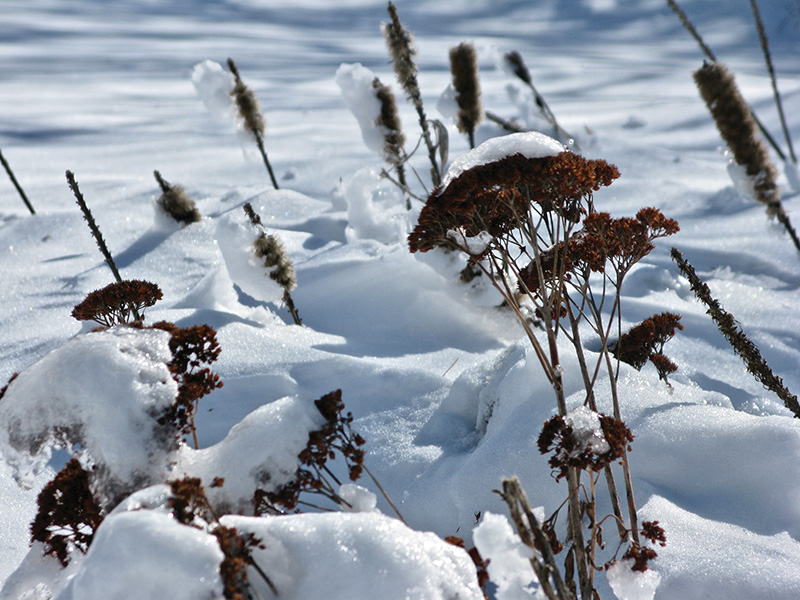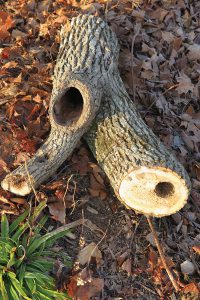
Lying in Wait
Our Gardens are Alive, Even in Winter

Allowing your garden plants to remain intact provides not only seed for winter birds but abundant places for beneficial insects to overwinter.
To garden for good—to really combine our love of gardening with our love of nature, to the benefit of both—is a four-season endeavor. You may not be thinking a lot about your garden, especially in midwinter, when it’s cold and grey outside.
But that’s exactly what I’d like you to do: look out at that quiet wintery landscape—the beds tucked in, the bare branches ticking in the wind—and imagine all the life that is there, waiting along with you, for spring.
There is a growing awareness and shift in how gardeners think of their home landscape. From Pollinator Pathways, spurred on by Doug Tallamy and others, to thinking about our collective neighborhoods as habitat for wildlife. More gardeners are making the shift to native plants, incorporating leaves into their beds as mulch, and—perhaps the most difficult to embrace—leaving the stalks and seed heads of last summer’s garden alone until spring.
Now is the time to understand why that matters, because outside in your garden—in the soil, in the hollow stems of your joe pye weed, nestled in the leaves you bundled under your shrubs—is what will make spring happen.
Most of the birds that we welcome in the spring—in the order of 96 percent of all land birds—feed insects to their young. In fact, all amphibians and many reptiles and mammals get much or all of their protein by eating insects. Despite our learned fear or revulsion to insects, they are essential to the food web that brings us spring robins, the wood thrush, spring peepers, and chipmunks. The more diverse and robust our insect population, the greater the availability of insect predators and parasitoids to control those insects that can damage our gardens.
We tend to focus on flowers when we think of gardens and honeybees when we think of pollinators. But many insects pollinate our flowers—and food—including flys, wasps, beetles, and bumblebees. And many places in our home landscapes support insects.
Life in last summer’s plants

“Save a dead tree or plant a log” is a good way to provide habitat for insects such as ants and beetles that will feed the birds.
Hollow or pith-filled plant stems are used by many of our less familiar, native, solitary pollinators to build chambered nests for their young. These pollinators include carpenter bees, leaf cutter bees, cavity-nesting wasps, and stem-boring moths. The dried stems and twigs of purple coneflower, sunflowers, beebalm, or blazing star, for example; the twigs of sumac and elderberry bushes; or the raspberry canes can all be used. Those hollow stems will both hatch next spring’s new bees as well as provide open nesting spaces for next summer’s generation to overwinter a year from now.
Switchgrass, Indian grass, and prairie dropseed—our native bunch grasses used as ornamental accents in our gardens—provide overwintering sites for bumblebee queens and predatory beetles. They may be nestled at the dense base of your plants, awaiting the warmth of spring.
The much-maligned goldenrod (because it is erroneously thought to cause hay fever) often hosts tiny fly larva over the winter within the safety of a small, round gall on the stem. Moths and some butterflies are overwintering in cryptic bundles of leaves suspended from the branches of your native shrubs, waiting to emerge in spring within quick reach of their host food.
The life in your fallen leaves
Every March I wait to hear the first sign of spring: the leaves on the ground start to make an ever-so-faint ticking sound. It is the first indication for me that the soil is coming alive and life is starting to rustle within the pockets of air and organic debris that has both fed and housed organisms through the winter. If you carefully lift a handful of cool, damp leaves at that moment you might see pill bugs, small spiders, ants, or millipedes setting the table for life above ground in a couple of months.

Many moths overwinter attached to the food plant they will need in the spring.
As the Xerces Society for Invertebrate Conservation tells us, leaves are not litter, but “home to an array of butterflies, beetles, bees, moths, and more.” And because you left them, as nature does, or bunched them up around your perennials and shrubs, a whole new layer of nutrients and organic matter is well underway for the next growing season. And the humidity those leaves are providing over the winter months help ensure that the organisms who seek refuge there can survive: cold and dry is deadly.
And because the magic of June nights rests with fireflies creating their very own ground-level constellations, it’s worth knowing that their larvae rely on leaf litter, too.
Life in the soil
This view from our winter window would not be complete without consideration of what lies beneath the snow: the soil. Despite the perceived barren plain of our winter yards and gardens, the eggs, and ultimately hatched larvae of solitary native bees are below ground awaiting their cues to emerge in the spring.
Last fall, a female mining bee, for example, may have found a small patch of bare soil in your yard, into which she excavated a tunnel. From there she further dug a series of branching tubes, each with one egg laid near a small provision of pollen and nectar, rolled into a tiny ball. Imagine these, now, below that winter landscape outside.
As spring nears, the developing bees—grown plump on their stashed food, will ready themselves to emerge. You can find the nest exit hole, looking like an ant mound but with the hole the width of a pencil. Despite our popular familiarity with the honeybee, it’s the solitary bee species that make up the majority of our native bee pollinators.
The list goes on: logs, tree snags, piles of stone, a protected eve in your shed—all can provide wintering sites for the insects that all of nature needs. They are, what the late Harvard professor and respected scientist E. O. Wilson proclaimed, “The little things that run the world.”
The biggest threat to our overwintering insects isn’t winter weather; it’s the lack of opportunity to find the resources and space to go about their lifecycles. We all can help, in many small ways, to ensure their success and in so doing enhance our own.
Judy Preston is a local ecologist active in the Connecticut River Estuary.

